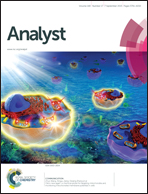Dopant-assisted reactive low temperature plasma probe for sensitive and specific detection of explosives
Abstract
A dopant-assisted reactive low temperature plasma (DARLTP) probe was developed for sensitive and specific detection of explosives by a miniature rectilinear ion trap mass spectrometer. The DARLTP probe was fabricated using a T-shaped quartz tube. The dopant gas was introduced into the plasma stream through a side-tube. Using CH2Cl2 doped wet air as the dopant gas, the detection sensitivities were improved about 4-fold (RDX), 4-fold (PETN), and 3-fold (tetryl) compared with those obtained using the conventional LTP. Furthermore, the formation of [M + 35Cl]− and [M + 37Cl]− for these explosives enhanced the specificity for their identification. Additionally, the quantities of fragment ions of tetryl and adduct ions such as [RDX + NO2]− and [PETN + NO2]− were dramatically reduced, which simplified the mass spectra and avoided the overlap of mass peaks for different explosives. The sensitivity improvement may be attributed to the increased intensity of reactant ion [HNO3 + NO3]−, which was enhanced 4-fold after the introduction of dopant gas. The limits of detection (LODs) for RDX, tetryl, and PETN were down to 3, 6, and 10 pg, respectively. Finally, an explosive mixture was successfully analyzed, demonstrating the potential of the DARLTP probe for qualitative and quantitative analysis of complicated explosives.


 Please wait while we load your content...
Please wait while we load your content...